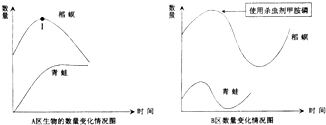某探究性学习小组调查了A、B两区稻田,统计了稻螟(水稻的害虫)和青蛙(稻螟的天敌)的数量变化情况,并绘制成如曲线图,据图回答有关问题:

(1)青蛙属于两栖动物,稻螟属于昆虫.青蛙和稻螟在发育过程中的相同点是______.
(2)稻螟在发育过程中有蜕皮现象.这是因为______.
(3)从图中Ⅰ点开始,A区稻螟逐渐减少的原因是______.
(4)B区使用了杀虫剂甲胺磷一段时间后,稻螟的数量增长至比使用前还多,为什么?______.
(5)从中你得到什么启示?______.
(1)青蛙的发育过程为:雄蛙先鸣叫吸引雌蛙,雌蛙来后雌雄蛙抱对,促进两性生殖细胞排出,两性生殖细胞在水中结合形成受精卵,许多受精卵在一起形成卵块,受精卵孵化出小蝌蚪,小蝌蚪先长后肢,再长前肢,最后尾巴逐渐消失,变成小幼蛙,幼蛙逐渐长成成蛙.即受精卵→蝌蚪→幼蛙→成蛙,青蛙的幼体和成体在系统结构和生活习性上差异很大,这样的发育属于变态发育.完全变态发育是昆虫变态地两种类型之一.昆虫在个体发育中,经过卵、幼虫、蛹和成虫等4个时期地叫完全变态发育.完全变态发育的幼虫与成虫在形态构造和生活习性上明显不同,差异很大.如稻螟.不完全变态发育过程为:卵→若虫→成虫(例如:蝗虫、螳螂、蝼蛄、蟋蟀),因此,青蛙和稻螟在发育过程中的相同点是变态发育.
(2)大多数的昆虫体表有外骨骼,起到保护、支撑和防止体内水分的散失,外骨骼不能随着身体的长大而变大,当昆虫逐渐长大时,外骨骼就会限制昆虫的生长,昆虫在生长过程中脱去外骨骼的现象就是蜕皮现象.因此,稻螟在发育过程中有蜕皮现象.
(3)从图中Ⅰ点开始,A区稻螟逐渐减少的原因是由于青蛙较多,稻螟被青蛙捕食,导致数量减少.
(4)B区使用了杀虫剂甲胺磷一段时间后,稻螟的数量增长至比使用前还多的原因是农药的使用毒杀了青蛙,并对稻螟进行了选择,存活的抗药性稻螟没有了天敌而数量迅速增加.
(5)从中得到启示是合理利用生物防治的方法,既有利于保护生物多样性,又有利于保护环境.
故答案为:
(1)变态发育
(2)外骨骼不能随身体长大而生长
(3)被青蛙捕食
(4)农药的使用毒杀了青蛙,并对稻螟进行了选择,存活的抗药性稻螟没有了天敌而迅速增加.
(5)合理利用生物防治的方法,既有利于保护生物多样性,又有利于保护环境.
